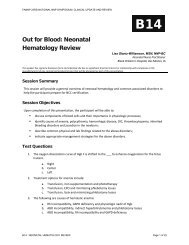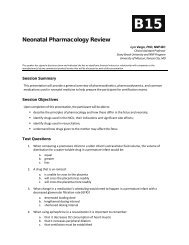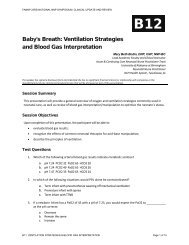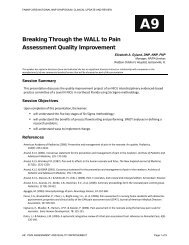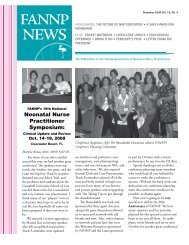Differential Diagnosis and Management of Respiratory ... - FANNP
Differential Diagnosis and Management of Respiratory ... - FANNP
Differential Diagnosis and Management of Respiratory ... - FANNP
You also want an ePaper? Increase the reach of your titles
YUMPU automatically turns print PDFs into web optimized ePapers that Google loves.
<strong>FANNP</strong> 23RD NATIONAL NNP SYMPOSIUM: CLINICAL UPDATE AND REVIEW<br />
Meconium Aspiration Syndrome<br />
Risk Factors<br />
•MAS is the most common aspiration syndrome that<br />
causes respiratory distress in the neonate.<br />
•Infants most commonly post-mature.<br />
•Can be seen in late term or term infants who have<br />
passed meconium in utero.<br />
•Posterm pregnancy<br />
•Preeclampsia- eclampsia<br />
•Maternal hypertension,<br />
chronic respiratory or<br />
cardiovascular disease<br />
•Maternal diabetes<br />
mellitus<br />
•Abnormal fetal heart<br />
pattern<br />
•IUGR<br />
•Abnormal biophysical<br />
pr<strong>of</strong>ile<br />
•Oligohydramnios<br />
•Maternal smoking<br />
Prevention<br />
Delivery Room <strong>Management</strong><br />
•Prenatal management<br />
• Identification <strong>of</strong> high risk<br />
pregnancies<br />
• Fetal monitoring<br />
• Amnioinfusion<br />
•Delivery room management<br />
•The goal <strong>of</strong> management <strong>of</strong> the infant is to decrease<br />
the severity <strong>of</strong> aspiration.<br />
•The sickest <strong>of</strong> these infants usually aspirated in<br />
utero <strong>and</strong> present with reactive pulmonary<br />
vasoconstriction.<br />
•Endotracheal intubation <strong>and</strong> suctioning <strong>of</strong> the airway<br />
is necessary in any infant with meconium stained fluid<br />
if the infant is not vigorous at birth.<br />
Delivery Room <strong>Management</strong><br />
Classic Sequence<br />
•Clinical judgment is required in deciding on the<br />
number <strong>of</strong> intubation/suctioning efforts.<br />
•Prolonged g suctioning is not recommended as it will<br />
exacerbate the preexisting asphyxial insult.<br />
•Further resuscitative measures such as ventilation<br />
<strong>and</strong> oxygenation will take priority in order to avoid or<br />
lessen pulmonary hypertension.<br />
•Airway obstruction – the thick material can result<br />
in simple acute upper airway obstruction.<br />
•The material progresses distally creating total or<br />
partial airway occlusion.<br />
•Atelectasis follows distal to the obstruction.<br />
•With partial airway obstruction, air can enter but<br />
cannot be exhaled (ball-valve phenomenon).<br />
•Results in air trapping <strong>and</strong> alveolar hyperexpansion.<br />
Great risk for air leak!<br />
•Chemical irritant leading to bronchial edema <strong>and</strong><br />
narrowing <strong>of</strong> the airways.<br />
B07: MANAGEMENT OF RESPIRATORY DISTRESS Page 15 <strong>of</strong> 23



